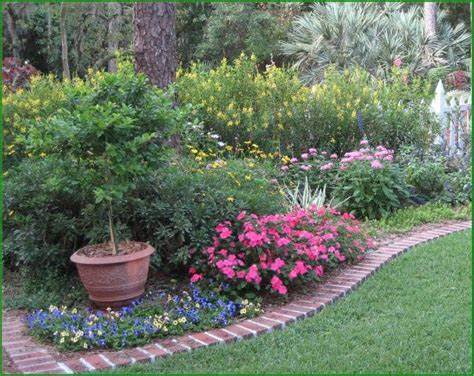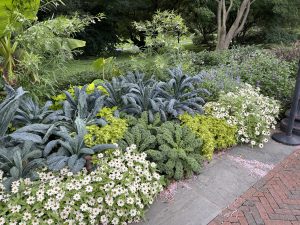
Garden Trends for 2024 can be summarized into one thought: landscape designs with altruistic objectives. The styles may vary but every garden space shares one common denominator, and that is sustainability.
Native Plants
Gardening continues to evolve globally in the eco-friendly markets, both in plant selection and design. Folks are still seeking refuge and appreciating the value that plants continue to offer in this post-pandemic time. And the benefits of nurturing nature keep stacking up. Despite constant changes in life, the living outside world consistently offers us an opportunity to grow our own food, save money, and uplift our spirit and connections. The demand for native plants, especially those that are sustainable and valuable to wildlife, has energized the horticultural market.

Edibles
The concept of incorporating edible plants into your landscape has been around for centuries. It wasn’t until 2008 when food costs had skyrocketed alongside a growing concern for the environment, that the turn back to growing your own food became popular. Gardeners have taken one of two paths:
- Foodscaping. Adding edibles to an existing bed (also referred to as foodscaping,)
- Edible Landscaping. starting from a clean slate with a mix of edible and nonedible companion flowers and plants (also referred to as edible landscaping).
Merging these two categories of plants, edibles and ornamentals, has led to the newer term, edimentals. Perennials, which are plants that typically live for more than one year, are being used to showcase their fun textures, forms, and complimentary colors. Popular herbs, such as lavender, rosemary and thyme, housed in pots are often inserted. Shrubs, vines and small trees are included in this elevated aesthetic appeal. The function and purpose can be achieved year-round with proper attention. With 20,000 edible plants worldwide, it can be a challenge to know where to start.
For a list of Florida friendly edible plants, please visit this link for more direction: https://gardeningsolutions.ifas.ufl.edu/plants/edibles/florida-edible-native-plants.html
New Wave Planting
For those who prefer a meadowy look, and low-to-no maintenance regimen, New Wave Planting could be your answer. This garden trend of 2024 involves a layout with plantings, grouped by variety and growing in very close proximity to each other. This style emulates gentle movement and flow. Preferred plants are those that reseed themselves so positioning the initial plants with a little drop zone is needed. Quantity is valued over order. The sheer volume of these plant groupings can’t help but to attract hordes of pollinators and shelter seeking wildlife. Wildflowers are the ideal plants for Naturalistic gardens because they reproduce in this manner while offering blooms year-round. Here are a few options to get your creative juices ideating:
- Salvia
- Black-eyed Susan/Rudbeckia hirta
- Purple Coneflower/Echinacea purpurea
- Tickseed/Coreopsis
If this setup sounds daunting to achieve, why not first check out the UF/IFAS guide to learn more about planning, preparing and managing this garden style at:
https://edis.ifas.ufl.edu/publication/IN1180.
Designate Purpose-Based Areas
Adapting to what the climate gives us, is forcing gardeners to mitigate challenging areas of their property into purposeful sections. Excessive rain that the soil does not quickly reabsorb can form puddles or lakes, depending on the size, in low lying ground. The dropline off a gutter less roof or the twist or turn of a gutter downward spout, can create a similar washout space. Converting these locations into rain gardens and swales reverses wasted water and partially diminishes irrigation demand. Plants with deep root structures become the filter for this resource and their growth fills what used to be wasted space. Many popular native plants and grasses that fall into this category are
- Horsetail/Equisetum spp,
- Cardinal flower/Lobelia cardinalis,
- Swamp milkweed/Asclepias incarnata,
- Yellow Canna/Canna flaccida and
- Florida Gamagrass/Tripsacum floridanum.
Extreme Weather
We are all looking for ways to offset the increasing number of days that are too hot, too cold, too dry, and too wet. Gardening in the future is shaping up to be a movement where gardeners are thinking outside their proverbial landscape box. Folks are utilizing their land and their available resources to grow smarter and more responsibly which in turn, benefits everyone and everything in our community.
This can be achieved in different styles with the right plants in the right place. If you are looking to expand your gardening knowledge, your county extension office is ready and available to help you learn. The staff publishes a free, informative bi-monthly newsletter called, A New Leaf, that can be emailed or paper mailed directly to you. For a preview of both the current and archived newsletters online, please go to:
https://sfyl.ifas.ufl.edu/duval/lawns-gardens-and-trees/new-leaf-newsletter/.
For in-class, hands on training, the Duval County extension office offers seminars and trainings at locations throughout the city. The next must-attend event, where our climate change designation of 9B will be discussed, plus the strong move towards sustainability, with illustrations of the garden trends for 2024, is the annual Day of Gardening. To register, please signup at
https://www.eventbrite.com/e/a-day-of-gardening-tickets-796291488277.
—
This article was written by Master Gardener, Candace Barone, who has not only designed several butterfly garden throughout Jacksonville, but grows an impressive amount of native plants herself. A seasoned Master Gardener, Candace will be on hand at the Duval County Extension Office Annual Plant Sale on March 30, 2024.
 5
5
